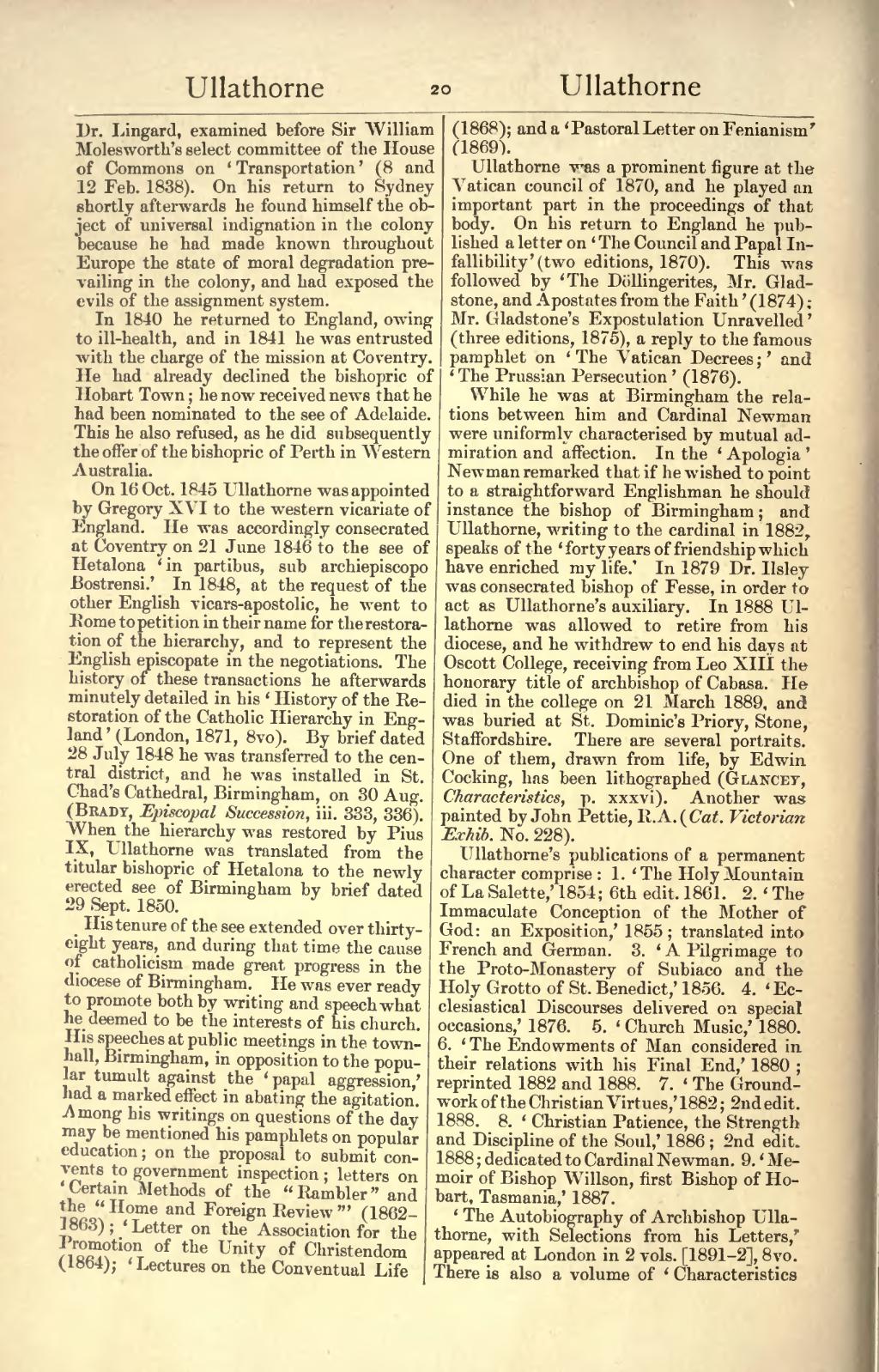Dr. Lingard, examined before Sir William Molesworth's select committee of the House of Commons on ‘Transportation’ (8 and 12 Feb. 1838). On his return to Sydney shortly afterwards he found himself the object of universal indignation in the colony because he had made known throughout Europe the state of moral degradation prevailing in the colony, and had exposed the evils of the assignment system.
In 1840 he returned to England, owing to ill-health, and in 1841 he was entrusted with the charge of the mission at Coventry. He had already declined the bishopric of Hobart Town; he now received news that he had been nominated to the see of Adelaide. This he also refused, as he did subsequently the offer of the bishopric of Perth in Western Australia.
On 16 Oct. 1845 Ullathorne was appointed by Gregory XVI to the western vicariate of England. He was accordingly consecrated at Coventry on 21 June 1846 to the see of Hetalona ‘in partibus, sub archiepiscopo Bostrensi.’ In 1848, at the request of the other English vicars-apostolic, he went to Rome to petition in their name for the restoration of the hierarchy, and to represent the English episcopate in the negotiations. The history of these transactions he afterwards minutely detailed in his ‘History of the Restoration of the Catholic Hierarchy in England’ (London, 1871, 8vo). By brief dated 28 July 1848 he was transferred to the central district, and he was installed in St. Chad's Cathedral, Birmingham, on 30 Aug. (Brady, Episcopal Succession, iii. 333, 336). When the hierarchy was restored by Pius IX, Ullathorne was translated from the titular bishopric of Hetalona to the newly erected see of Birmingham by brief dated 29 Sept. 1850.
His tenure of the see extended over thirty-eight years, and during that time the cause of catholicism made great progress in the diocese of Birmingham. He was ever ready to promote both by writing and speech what he deemed to be the interests of his church. His speeches at public meetings in the town-hall, Birmingham, in opposition to the popular tumult against the ‘papal aggression,’ had a marked effect in abating the agitation. Among his writings on questions of the day may be mentioned his pamphlets on popular education; on the proposal to submit convents to government inspection; letters on ‘Certain Methods of the “Rambler” and the “Home and Foreign Review”’ (1862–1863); ‘Letter on the Association for the Promotion of the Unity of Christendom’ (1864); ‘Lectures on the Conventual Life’ (1868); and a ‘Pastoral Letter on Fenianism’ (1869).
Ullathorne was a prominent figure at the Vatican council of 1870, and he played an important part in the proceedings of that body. On his return to England he published a letter on ‘The Council and Papal Infallibility’ (two editions, 1870). This was followed by ‘The Döllingerites, Mr. Gladstone, and Apostates from the Faith’ (1874); ‘Mr. Gladstone's Expostulation Unravelled’ (three editions, 1875), a reply to the famous pamphlet on ‘The Vatican Decrees;’ and ‘The Prussian Persecution’ (1876).
While he was at Birmingham the relations between him and Cardinal Newman were uniformly characterised by mutual admiration and affection. In the ‘Apologia’ Newman remarked that if he wished to point to a straightforward Englishman he should instance the bishop of Birmingham; and Ullathorne, writing to the cardinal in 1882, speaks of the ‘forty years of friendship which have enriched my life.’ In 1879 Dr. Ilsley was consecrated bishop of Fesse, in order to act as Ullathorne's auxiliary. In 1888 Ullathorne was allowed to retire from his diocese, and he withdrew to end his days at Oscott College, receiving from Leo XIII the honorary title of archbishop of Cabasa. He died in the college on 21 March 1889, and was buried at St. Dominic's Priory, Stone, Staffordshire. There are several portraits. One of them, drawn from life, by Edwin Cocking, has been lithographed (Glancey, Characteristics, p. xxxvi). Another was painted by John Pettie, R.A. (Cat. Victorian Exhib. No. 228).
Ullathorne's publications of a permanent character comprise: 1. ‘The Holy Mountain of La Salette,’ 1854; 6th edit. 1861. 2. ‘The Immaculate Conception of the Mother of God: an Exposition,’ 1855; translated into French and German. 3. ‘A Pilgrimage to the Proto-Monastery of Subiaco and the Holy Grotto of St. Benedict,’ 1856. 4. ‘Ecclesiastical Discourses delivered on special occasions,’ 1876. 5. ‘Church Music,’ 1880. 6. ‘The Endowments of Man considered in their relations with his Final End,’ 1880; reprinted 1882 and 1888. 7. ‘The Groundwork of the Christian Virtues,’ 1882; 2nd edit. 1888. 8. ‘Christian Patience, the Strength and Discipline of the Soul,’ 1886; 2nd edit. 1888; dedicated to Cardinal Newman. 9. ‘Memoir of Bishop Willson, first Bishop of Hobart, Tasmania,’ 1887.
‘The Autobiography of Archbishop Ullathorne, with Selections from his Letters,’ appeared at London in 2 vols. [1891–2], 8vo. There is also a volume of ‘Characteristics
